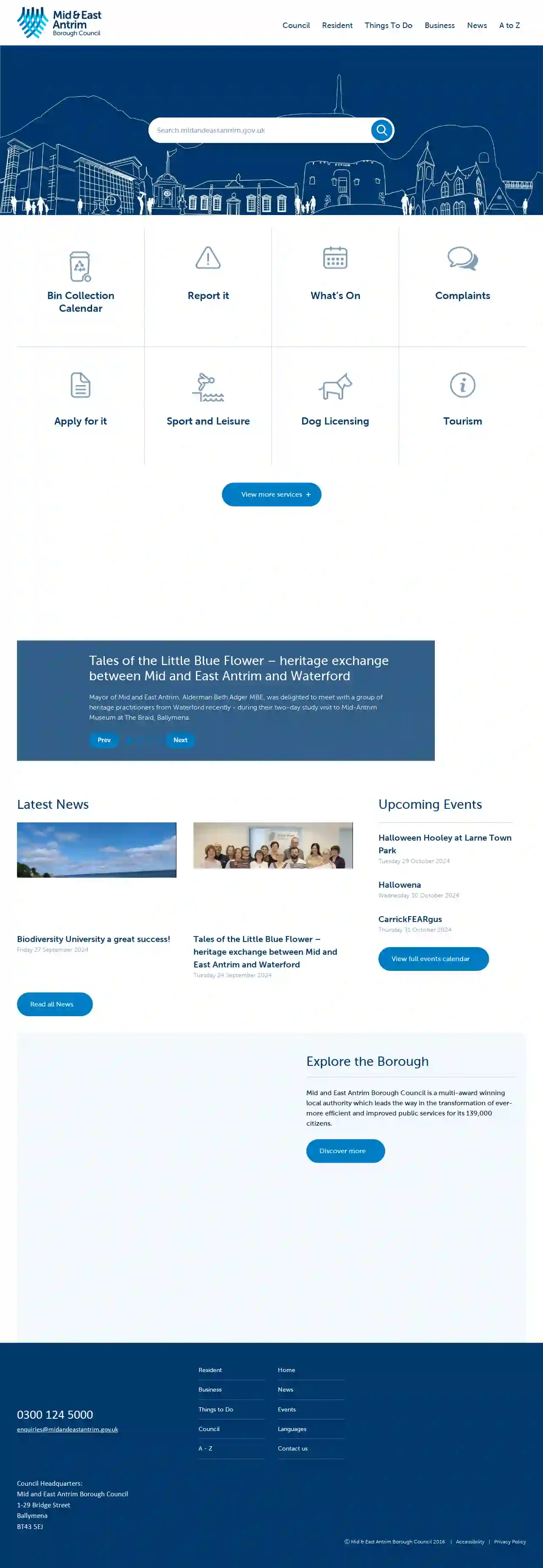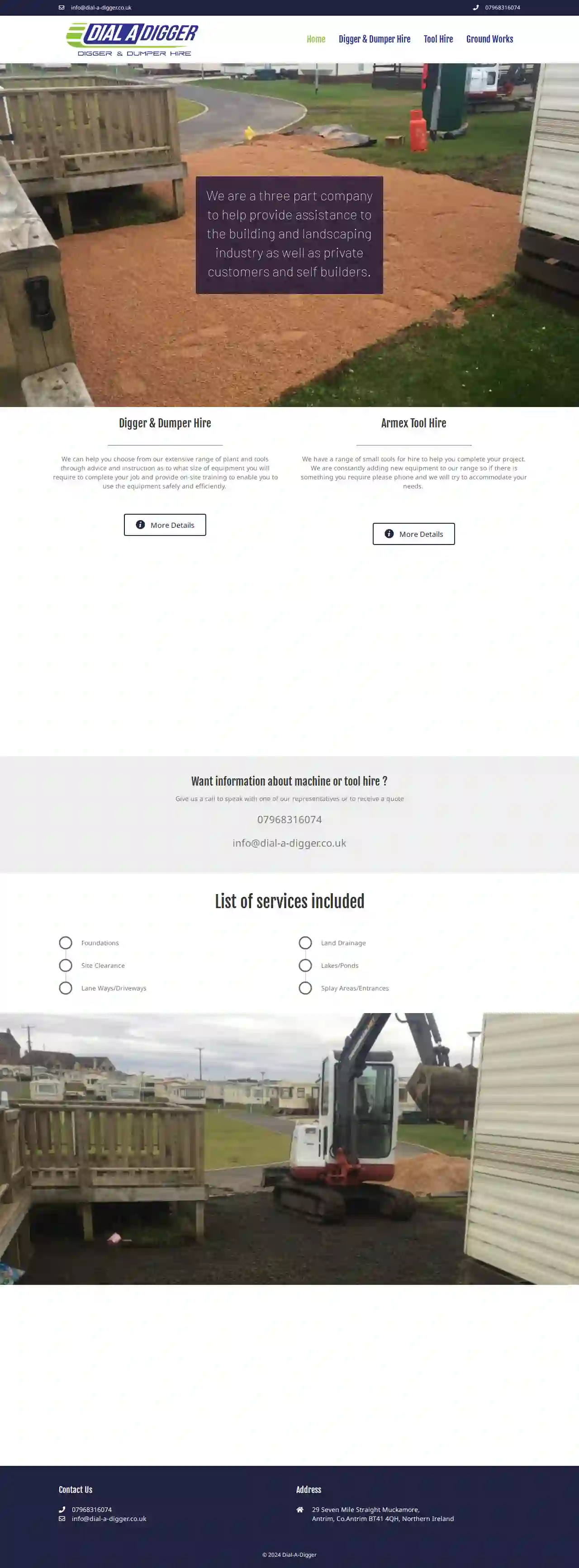Demolition Contractors Antrim
Find the best Demolition Contractors Near Me in Antrim
Get multiple Demolition Contractors Near Me quotes for your project today! Compare profiles, reviews, accreditations, portfolio, etc... and choose the best service.

Mid and East Antrim Borough Council
52 reviewsCarrickfergus Museum & Civic Centre, 11 Antrim Street, Carrickfergus, BT38 7DG, GBAbout Mid and East Antrim Borough Council Mid and East Antrim Borough Council is a multi-award winning local authority which leads the way in the transformation of ever-more efficient and improved public services for its 139,000 citizens. Our History Mid and East Antrim was formed in the shadow format following the elections on 22 May 2014, when 40 elected members were appointed to represent the new area, replacing the predecessor councils of Ballymena, Carrickfergus and Larne Borough Councils from 1 April 2015. The new Council was established as part of the programme for local government reform, the most significant change in over 40 years. The purpose of the reform process is to create a “thriving dynamic local government that creates vibrant, healthy, prosperous, safe and sustainable communities that meets the needs of the citizens” and aims to deliver improved service provision and long-term cost savings. For us, this provides a once in a political lifetime opportunity to do things differently and to do different things. Our focus is always to improve the quality of life for our citizens.
- Services
- Why Us?
- Gallery
Get Quote
Dial A Digger- Dumper Digger Hire Ground Works.
4.818 reviews29 Seven Mile Straight Muckamore, Antrim, Co.Antrim, BT41 4QH, GBDial-A-Digger: Your One-Stop Shop for Digger & Dumper Hire, Tool Hire, and Ground Works Dial-A-Digger is a comprehensive company dedicated to providing top-notch services to the building and landscaping industry, as well as private customers and self-builders. We offer a wide range of services, including digger and dumper hire, tool hire, and ground works. Our team is committed to providing expert advice and guidance to help you choose the right equipment for your project, ensuring you have the tools and knowledge to complete your job safely and efficiently. Whether you're a seasoned professional or a DIY enthusiast, Dial-A-Digger has the equipment and expertise to meet your needs. We pride ourselves on our extensive range of plant and tools, and we're always adding new equipment to our inventory. If you have a specific requirement, don't hesitate to give us a call, and we'll do our best to accommodate your needs.
- Services
- Why Us?
- Gallery
Get Quote- Be
Bespoke Landscaping Projects Ltd
56 reviewsAntrim, GB- Services
- Why Us?
Get Quote - El
Elmwood Construction
Antrim, GB- Services
- Why Us?
Get Quote - AJ
AJ McMinn Groundworks & Plant Hire
51 reviewsAntrim, GB- Services
- Why Us?
Get Quote - Am
Ammlee Group International Ltd
53 reviewsAntrim, GB- Services
- Why Us?
Get Quote
Over 13,059+ Excavation Contractors on our platform
Our excavation contractors operate in Antrim & surrounding areas!
ExcavationHQ has curated and vetted the Best Excavation Businesses arround Antrim. Find a reliable contractor today.
Frequently Asked Questions About Demolition Contractors
- Project Assessment: The demolition contractor evaluates the structure, site conditions, and project requirements.
- Permitting: Obtain necessary demolition permits from local authorities.
- Site Preparation: Secure the site, disconnect utilities, and remove any valuable or reusable items.
- Hazardous Material Abatement: Professionally remove asbestos, lead paint, or other hazardous materials if present.
- Demolition: Execute the chosen demolition method, bringing down the structure safely and efficiently.
- Debris Removal and Site Cleanup: Sort, process, and dispose of demolition debris responsibly. Clean up the site to prepare it for future use.
- Safety: Experienced contractors have the knowledge, skills, and safety training to execute demolitions safely, minimizing risks to workers and surrounding areas.
- Efficiency: Contractors have the specialized equipment and expertise to complete demolitions efficiently, saving time and reducing project costs.
- Compliance: Reputable contractors are familiar with local regulations and permitting requirements, ensuring compliance and avoiding legal issues.
- Waste Management: Contractors have waste management plans to handle debris responsibly, including recycling and proper disposal.
- Liability Protection: Insured contractors protect you from financial responsibility for accidents or damages during the demolition process.
- Site Security: Secure the demolition site with fencing and warning signs to prevent unauthorized access.
- Personal Protective Equipment (PPE): Workers should wear appropriate PPE, including hard hats, safety glasses, gloves, and steel-toe boots.
- Hazardous Material Removal: Properly identify and remove asbestos, lead paint, or other hazardous materials before demolition begins.
- Utility Disconnections: Disconnect all utilities, such as electricity, gas, and water, before demolition.
- Controlled Demolition Techniques: Employ controlled demolition methods to minimize risks and ensure the structure comes down safely.
- Dust Control: Implement dust suppression measures, such as water spraying or misting, to reduce airborne particles and protect air quality.
- Emergency Planning: Have an emergency plan in place, including communication protocols and evacuation procedures, in case of unforeseen events.
- Implosion: Using explosives to collapse a structure inwards rapidly. Suitable for large buildings in open areas.
- Wrecking Ball: Swinging a large steel ball to impact and break down the structure. Effective for bringing down walls and other solid elements.
- High-Reach Demolition: Utilizing specialized excavators with extended arms and demolition attachments for dismantling tall structures piece by piece.
- Selective Demolition: Removing specific parts of a building while preserving other sections. Often used in renovation projects.
- Deconstruction: Carefully dismantling a building to salvage reusable materials, reducing waste and environmental impact.
What are the steps involved in a typical demolition process?
What are the benefits of hiring a professional demolition contractor?
What are the safety precautions for demolition?
What are the different types of demolition?
What are the steps involved in a typical demolition process?
- Project Assessment: The demolition contractor evaluates the structure, site conditions, and project requirements.
- Permitting: Obtain necessary demolition permits from local authorities.
- Site Preparation: Secure the site, disconnect utilities, and remove any valuable or reusable items.
- Hazardous Material Abatement: Professionally remove asbestos, lead paint, or other hazardous materials if present.
- Demolition: Execute the chosen demolition method, bringing down the structure safely and efficiently.
- Debris Removal and Site Cleanup: Sort, process, and dispose of demolition debris responsibly. Clean up the site to prepare it for future use.
What are the benefits of hiring a professional demolition contractor?
- Safety: Experienced contractors have the knowledge, skills, and safety training to execute demolitions safely, minimizing risks to workers and surrounding areas.
- Efficiency: Contractors have the specialized equipment and expertise to complete demolitions efficiently, saving time and reducing project costs.
- Compliance: Reputable contractors are familiar with local regulations and permitting requirements, ensuring compliance and avoiding legal issues.
- Waste Management: Contractors have waste management plans to handle debris responsibly, including recycling and proper disposal.
- Liability Protection: Insured contractors protect you from financial responsibility for accidents or damages during the demolition process.
What are the safety precautions for demolition?
- Site Security: Secure the demolition site with fencing and warning signs to prevent unauthorized access.
- Personal Protective Equipment (PPE): Workers should wear appropriate PPE, including hard hats, safety glasses, gloves, and steel-toe boots.
- Hazardous Material Removal: Properly identify and remove asbestos, lead paint, or other hazardous materials before demolition begins.
- Utility Disconnections: Disconnect all utilities, such as electricity, gas, and water, before demolition.
- Controlled Demolition Techniques: Employ controlled demolition methods to minimize risks and ensure the structure comes down safely.
- Dust Control: Implement dust suppression measures, such as water spraying or misting, to reduce airborne particles and protect air quality.
- Emergency Planning: Have an emergency plan in place, including communication protocols and evacuation procedures, in case of unforeseen events.
What are the different types of demolition?
- Implosion: Using explosives to collapse a structure inwards rapidly. Suitable for large buildings in open areas.
- Wrecking Ball: Swinging a large steel ball to impact and break down the structure. Effective for bringing down walls and other solid elements.
- High-Reach Demolition: Utilizing specialized excavators with extended arms and demolition attachments for dismantling tall structures piece by piece.
- Selective Demolition: Removing specific parts of a building while preserving other sections. Often used in renovation projects.
- Deconstruction: Carefully dismantling a building to salvage reusable materials, reducing waste and environmental impact.